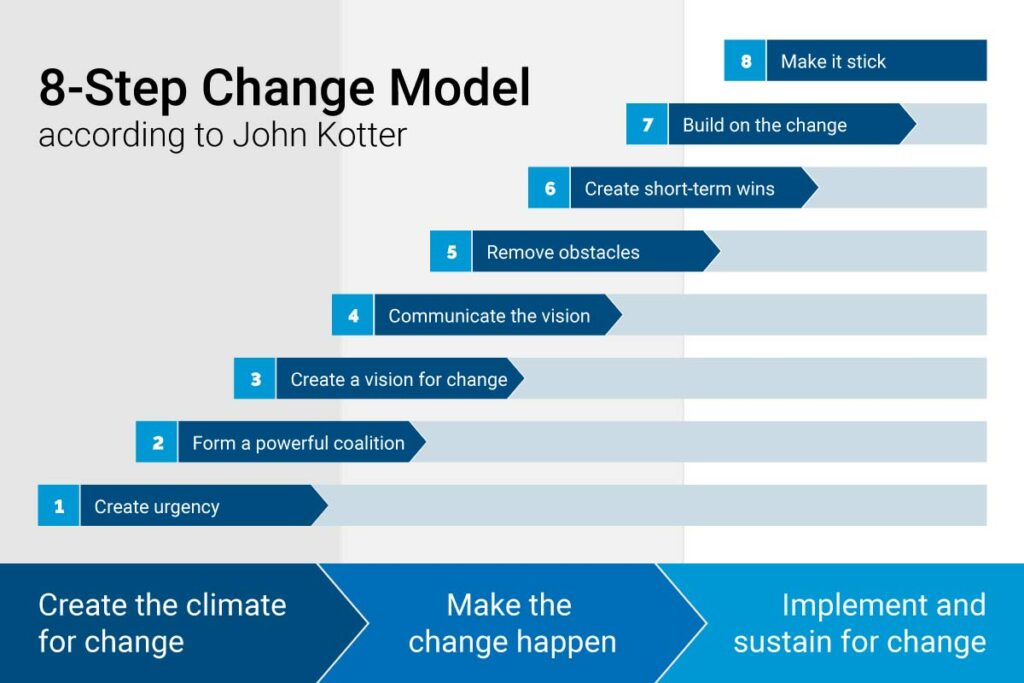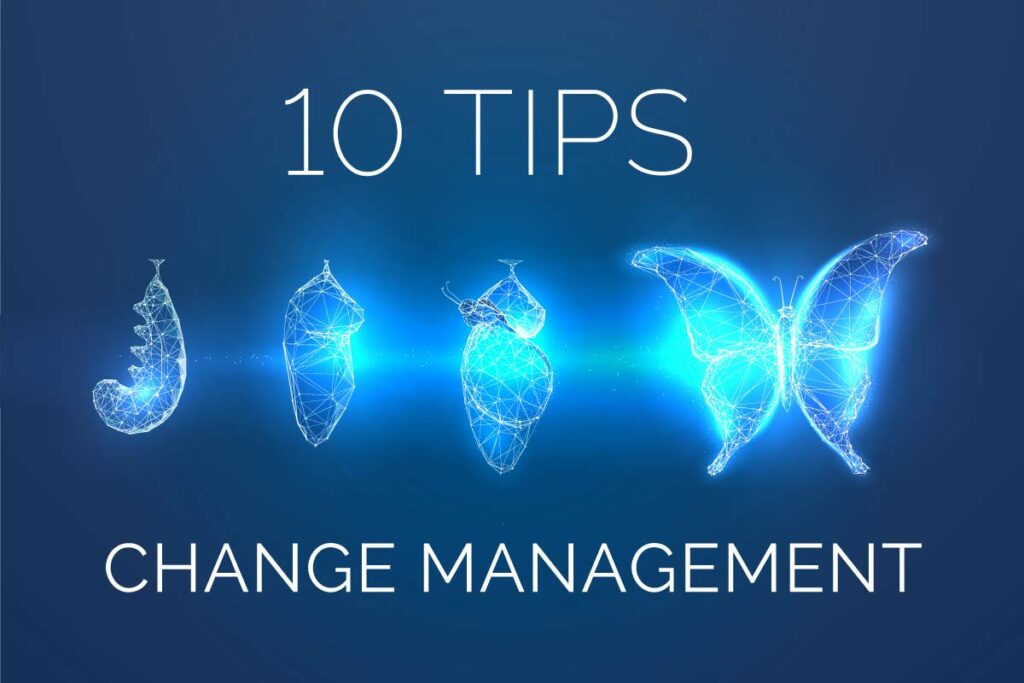At Growth Ninjas we see a lot of Customer Relationship Management (CRM) implementations. Some projects we start from scratch, working with our clients to plan, implement and drive adoption. Many companies, however, start implementing a CRM tool without any external support, some of them getting stuck after a while with poor data quality, spotty adoption, lack of integration with other tools. These are just a few of the symptoms that have popped up, when we get a call for help.
Many studies show that a successful implementation is not a given: depending on the source, research claims that between 30% and 60% of CRM implementations fail! At Growth Ninjas, we have found that one of the most common mistakes is not managing the CRM implementation as a company-wide change project.
In this article, we’ll explore why solid change management is critical to a successful CRM implementation and provide 10 tips on how organizations can effectively manage the process.
CRM at the Heart of the Sales & Marketing Engine
It is widely proven that implementing a CRM system can drive a step-change in the way companies interact with customers, streamline sales and marketing processes, and eventually drive profitable growth. In addition, recent studies show that a well-implemented CRM can significantly improve collaboration across departments and roles.
However, the success of a CRM implementation depends on much more than choosing the right technology. Implementing a CRM is more than just setting up a tool; it often represents a fundamental change in corporate culture. This change process requires a rock-solid, people-centric change management strategy to ensure company-wide and long-term adoption.
Mastering change management as a practice requires deep understanding and training. For simplicity, this article breaks it down into three key phases: 1) creating the climate for change, 2) making the change happen, and 3) sustaining the change. Let’s apply this to a CRM project.

Creating the right Climate for your CRM project
Change starts and ends with people embracing the change. As tools and processes are enablers, not drivers, early buy-in from employees at all levels and across various departments is critical for long term adoption and success. This phase should not be approached too hastily, as it will determine how bumpy or smooth the road ahead will be.
Tip 1: Ensure leadership support
Executive buy-in is essential for successful change management. Executives, however, should not only support the CRM implementation, but also champion it, communicate its strategic importance, and lead by example in embracing the change.
Tip 2: Engage stakeholders early
Engaging key stakeholders from different departments early in the project is key to building a strong coalition. At this stage, it is important to seek their input and address their concerns. Starting the project with mutually agreed upon goals and desired outcomes will gain their support in driving future adoption.
Tip 3: Talk to the emotions
While the analytical brain understands the business need for a new tool or system, real buy-in comes when people are emotionally involved. Try to make the impact of the new process tangible, for example, by getting a testimonial from a current or former customer who had a bad experience due to a lack of integrated systems, poor communication, poor data quality, and so on.
Do you have any further questions about change management or can we support you with HubSpot CRM? Don’t hesitate and contact us right now – we will be happy to advise you!
Making the Change Happen while Implementing the Project
When the implementation is ready to be kicked off, the goals are defined, technology choices have been made, and key stakeholders are on board, the hard work begins. This may also lead to a short period of disruption. People will have to give up old ways of doing things and may even experience a temporary drop in productivity as they adopt the new systems and processes. During this phase, it is critical to spend a lot of time and effort guiding people through the change.
Tip 4: Over-communicate
Communicate consistently and transparently throughout the CRM implementation process and communicate a lot. Let me repeat: a lot! Provide regular updates, share successes as well as challenges and solicit feedback from employees. If you have an implementation partner that applies agile project management techniques (e.g. SCRUM), feedback can be quickly incorporated in the implementation and people will feel part of the process.
Tip 5: Identify and manage resistance
Change always breeds resistance, whether it’s due to fear of the unknown, loss of control, or skepticism about the benefits. It is key to identify potential sources of resistance early on and develop tactics to address them. By actively engaging employees, providing transparency and addressing concerns early in the process, resistance can be mitigated. Remember: resistance is an expression of passion; those expecting engagement, make resistance a duty!
Tip 6: Celebrate Early Successes
Recognizing and celebrating milestones and successes throughout the CRM implementation journey is an easy way to sustain emotional buy-in. This helps maintain momentum, boost morale, and reinforce the value of the changes being made. Moreover, it is a great way to provide kudos to individuals who are embracing the change.
Turning the CRM tool into a company culture
Once your system is up and running, the first wins have been celebrated, and early resistance has been mitigated, the project enters the phase of making CRM a central part of the company’s culture. At this point, the implementation partner often steps aside and hands over management of the CRM system to the customer. From this point, things can go in many directions, from excellence and continuous improvement to drift and disaster. To avoid the latter, we recommend implementing a few critical checks and balances to ensure the train stays on track.
Tip 7: Define at least one super admin with policing authority
While large organizations take it for granted to have dedicated CRM administrators, smaller organizations often don’t. At Growth Ninjas, we have seen beautiful implementations drift away due to lack of ownership, resulting in poor data quality, wild growth of reports, fields and attributes, and eventually people dropping out. Even for small companies, it is still paramount to have at least one clear owner with super-admin rights at the technical level, but even more importantly, with the authority in the organization to police a clean CRM practice.
Tip 8: Drive continuous improvements
Business changes quickly, and so does CRM technology. Keeping up with feature releases and adapting both business processes and tools is key to staying ahead of the competition. Relying on an external partner to help with this continuous improvement can be a wise investment.
Tip 9: Perform regular health checks
A healthy and well-performing CRM system relies on accurate and high-quality data, but as the old saying goes: garbage in, garbage out. Having analyzed many CRM systems, at Growth Ninjas we have learned that data quality tends to deteriorate quickly if not monitored on an ongoing basis. In addition, modern tools allow for a great deal of customization, even by employees themselves. While this encourages exploration and maximization of the tool’s capabilities, it can quickly lead to a proliferation of features, workflows, lists, etc. In addition to enforcing user discipline and building in real-time controls, we strongly recommend regular health checks at all levels of the system. Also here, having an external partner to audit your system on a regular basis may be helpful.
Conclusion
Implementing CRM is an incredibly exciting journey that unlocks a tremendous amount of opportunity for any organization to drive growth, customer satisfaction, and happiness among your employees. Starting this journey well prepared, with the best possible tool, the right partner, and strong change management will dramatically improve the chances of success.
Tip 10
In closing, I still owe Tip 10: Enjoy the ride! It’s worth it.
Do you have any further questions about change management or can we support you with HubSpot CRM? Don’t hesitate and contact us right now – we will be happy to advise you!



